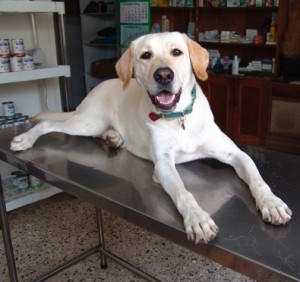Canine Well Care Essential To Prevent Chronic Disease
By J. Scott Hemenway, DVM // July 29, 2012
Pet Health
BREVARD COUNTY–There is increasing concern that the economy has resulted in more and more people choosing low cost vaccinations and Internet medications for their pets. This comes at the expense of our furry friend’s wellbeing. The vaccinations are important, but the primary reason we should be taking our animals to the veterinarian, is for regular examinations and education, which you do not receive at clinics.
Annual Exam Up to Age 8, Biannual For ‘Seniors’

A thorough physical examination is important at least once a year for young adults (those animals 6 months to 8 years old) and twice a year minimum for seniors. Think about “dog years,” while not actually a linear 7:1 ratio, our pets age much faster than a human. A Labrador retriever for instance grows from birth to 18-20 (comparative to a human) in just the first 8 months of life. The next few years, a dog may actually mature an equivalent of 4-7 human years per calendar year. This makes that cute little puppy a senior by the time it is 5-7 years old. Now think about a human that is middle aged or near retirement. Would they wait 4-7 years between doctor visits? That is exactly the case if your senior canine is seeing the vet for an exam only once a year.
Systematic Approach To Exam Is Key

Although knowledgeable, veterinarian technicians are not qualified to make medical judgment of health, so make sure your vet is doing the exam. Your doctor should have a systematic approach to evaluating the animal’s health. For example, my exam actually starts as I enter the room. I am assessing your pet’s body condition and demeanor. I watch the animal to see if they are listening to and watching me, this can help me recognize vision or hearing issues.
Next, regardless of the reason for the visit, I start by examining our furry friend’s head, focusing first on their eyes. Is there any abnormal coloration, discharge, or difference in pupil size from left to right? Do the pupils respond properly to light and movement? Moving to the ears—is there any discharge, odor, hair loss, hearing deficit or pain with petting and manipulation?

Ear infections are common and require cytology (microscopic evaluation) and cultures to properly identify the causative organisms and the proper medication for effective treatment.
Examination of the mouth is where the most problems are routinely found. Issues with the bite, dental plaque and tarter, and gingivitis, sometimes tumors, problems with the tongue, swallowing reflex, tonsils, etc.
The bacteria from the mouth can cause serious health problems throughout the body, including heart, kidneys, and liver. Dental disease is a serious condition and when it is recommended to schedule an appointment to have their teeth cleaned, please do so. You should care for your pet’s teeth as if they were your own. Head and neck lymph nodes, the skin and overall symmetry are also evaluated.
From the head, I tend to work towards the back, inch by inch. There are lymph nodes to feel. The skin needs to be felt as well as looked at to fully understand if it is healthy.

Often, growths are found either on the skin or beneath it. A skin problem may have a simple explanation, such as fleas, or be much more complicated. However, because there are over 1000 conditions that can cause itching, it is best to investigate for a specific cause rather than administer a “knee-jerk” steroid injection like some vets tend to do.
When the belly is reached, the abdominal organs are palpated for proper position, size, shape, or discomfort. Is there excessive fluid present? A mass? Then I move on to check the hind end, feel up and down the limbs and manipulate the joints.
I typically save auscultation of the heart and lungs, the most important aspect of the exam, for last, so that the animal has had a chance to relax somewhat. The less stress the dog is feeling the better the heart sounds and rhythm, and breathing patterns can be heard with the stethoscope. The heart has four valves, and there are additional sounds, which can be heard as chambers fill with blood or relax after a beat. The lungs should sound clear and have air flowing to the expected borders of the field.
Candid Communication Builds Trust Between Vet and Pet Owner

After my basic exam, the pet owner and I focus on the reasons for the visit, discuss the animal’s overall condition, as well as any specific findings from the exam. I take this time to candidly communicate and build trust with the pet owner. Diet and age-appropriate exercise are important for overall well-being. Unfortunately, obesity is rampant, and the resultant health risks are far reaching, just as they are with humans.
Veterinarians are seeing an increasing incidence of chronic disease. The primary factor for this is directly related to decreased veterinary examinations and increased use of Internet information for the do-it-yourself pet owners. Both the public and our pets benefit when we look at the long-term costs of quality preventative care and education, versus having to manage chronic disease, which went undiagnosed due to lack of attention. So, put your pet on a regular schedule of medical and dental evaluation and preventive care.
ABOUT THE AUTHOR

Dr. Scott Hemenway is a Doctor of Veterinary Medicine at Minton Animal Hospital in Palm Bay. A native of Pennsylvania, Dr. Hemenway earned his Masters Degree from the University of Maryland in Parasitology, his DVM at Ross University in St. Kitts, West Indies, and completed his internship at Oklahoma State University, where he spent considerable time in radiology and large animal surgery rotations. Dr. Hemenway worked at a veterinary clinic in York, PA before relocating to Brevard County, Florida in 2004. He has a particular interest in small animal medicine and preventive care. For more information, log on to MintonVet.com or call 321-724-1445.












